DAQ1200 User Guide: Difference between revisions
No edit summary |
No edit summary |
||
| Line 24: | Line 24: | ||
{{ugDigitalInput|DAQ1200|{{UGDigitalInputActiveLow}}}} | {{ugDigitalInput|DAQ1200|{{UGDigitalInputActiveLow}}}} | ||
{{ugAddressingInformation}} | |||
===Using Your Own Program=== | |||
You are now ready to start writing your own code for the device. The best way to do that is to start from our examples: | |||
This Phidget is compatible with the {{ExampleLink|DigitalInput}}. | |||
Once you have your example, you will need to follow the instructions on the page for your programming language to get it running. To find these instructions, select your programming language from the [[Software_Overview#Language_Support|Software Overview]] page. | |||
==Technical Details== | ==Technical Details== | ||
Revision as of 16:45, 27 August 2018
Getting Started
Welcome to the DAQ1200 user guide! In order to get started, make sure you have the following hardware on hand:
- DAQ1200 - 4x Digital Input Phidget
- VINT Hub
- Phidget cable
- USB cable and computer
- something to use with the DAQ1200 (e.g. switch or digital sensor with a digital output)
Next, you will need to connect the pieces:
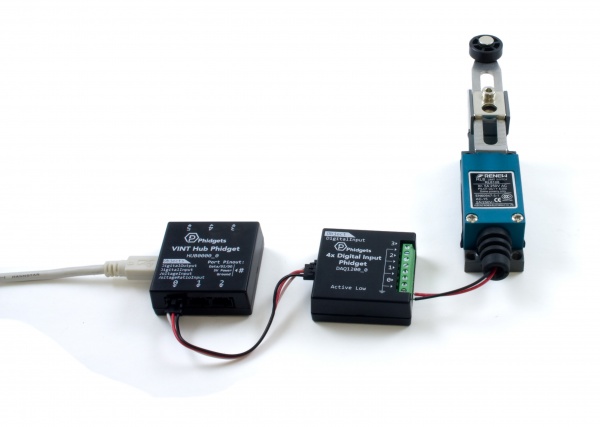
- Connect the DAQ1200 to the VINT Hub using the Phidget cable.
- Connect the VINT Hub to your computer with a USB cable.
- Connect a switch or digital sensor to one of the DAQ1200's inputs.
Now that you have everything together, let's start using the DAQ1200!.
Using the DAQ1200
Phidget Control Panel
In order to demonstrate the functionality of the DAQ1200, the Phidget Control Panel running on a Windows machine will be used.
The Phidget Control Panel is available for use on both macOS and Windows machines.
Windows
To open the Phidget Control Panel on Windows, find the ![]() icon in the taskbar. If it is not there, open up the start menu and search for Phidget Control Panel
icon in the taskbar. If it is not there, open up the start menu and search for Phidget Control Panel
macOS
To open the Phidget Control Panel on macOS, open Finder and navigate to the Phidget Control Panel in the Applications list. Double click on the ![]() icon to bring up the Phidget Control Panel.
icon to bring up the Phidget Control Panel.
For more information, take a look at the getting started guide for your operating system:
Linux users can follow the getting started with Linux guide and continue reading here for more information about the DAQ1200.
First Look
After plugging the DAQ1200 into your computer and opening the Phidget Control Panel, you will see something like this:
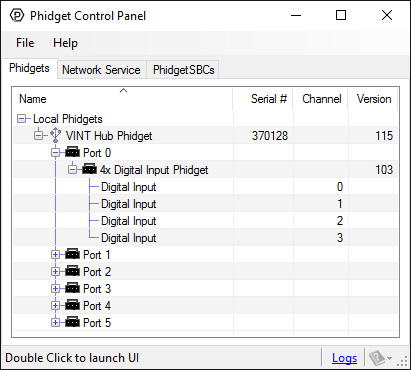
The Phidget Control Panel will list all connected Phidgets and associated objects, as well as the following information:
- Serial number: allows you to differentiate between similar Phidgets.
- Channel: allows you to differentiate between similar objects on a Phidget.
- Version number: corresponds to the firmware version your Phidget is running. If your Phidget is listed in red, your firmware is out of date. Update the firmware by double-clicking the entry.
The Phidget Control Panel can also be used to test your device. Double-clicking on an object will open an example.
Digital Input
Double-click on a Digital Input object in order to run the example:
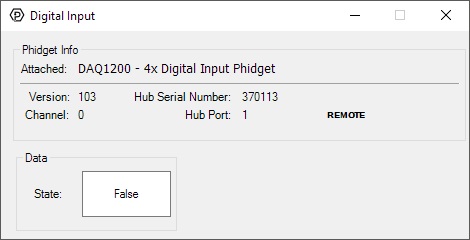
General information about the selected object will be displayed at the top of the window. You can also experiment with the following functionality:
- This is an active-low device, therefore, it will be true when connected to ground, and false when connected to a high voltage.
For more information about Digital Inputs, take a look at the Digital Input Primer
Finding The Addressing Information
Before you can access the device in your own code, and from our examples, you'll need to take note of the addressing parameters for your Phidget. These will indicate how the Phidget is physically connected to your application. For simplicity, these parameters can be found by clicking the button at the top of the Control Panel example for that Phidget.

In the Addressing Information window, the section above the line displays information you will need to connect to your Phidget from any application. In particular, note the Channel Class field as this will be the API you will need to use with your Phidget, and the type of example you should use to get started with it. The section below the line provides information about the network the Phidget is connected on if it is attached remotely. Keep track of these parameters moving forward, as you will need them once you start running our examples or your own code.

Using Your Own Program
You are now ready to start writing your own code for the device. The best way to do that is to start from our examples:
This Phidget is compatible with the DigitalInput Examples.
Once you have your example, you will need to follow the instructions on the page for your programming language to get it running. To find these instructions, select your programming language from the Software Overview page.
Technical Details
General
The DAQ1200 features four digital input terminals, all of which share a common ground. Each input has a built-in pull-up resistor to allow for easy interfacing to all manner of switches.
Example Use
Here are a few things you can do with the DAQ1200 Digital Input Phidget
Use with a Switch
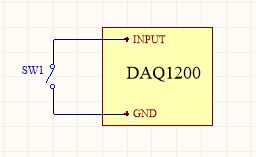
To interface a switch with the DAQ1200, simply connect the switch across the input and ground terminals for a channel.
Use with 5V Logic Level Devices

The DAQ1200 can also detect signals from 5V logic level devices. Be aware that the input is active-low, which means that LOW voltages will be detected as TRUE, and HIGH voltages as FALSE.
Isolation with Optocouplers
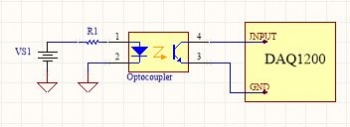
In some applications, particularly where there is a lot of electrical noise (automotive), or where you want maximum protection of the circuitry (interactive installations, kiosks), electrical isolation buys you a huge margin of protection.
If wired according to the diagram, driving the LED will cause the DAQ1200 to report TRUE.
Note that in cases where many isolated inputs are required, or for simplicity's sake, you may want to consider using the DAQ1300 or DAQ1301, which are (more sophisticated) ready-made isolated digital input Phidgets.
What to do Next
- Programming Languages - Find your preferred programming language here and learn how to write your own code with Phidgets!
- Phidget Programming Basics - Once you have set up Phidgets to work with your programming environment, we recommend you read our page on to learn the fundamentals of programming with Phidgets.
